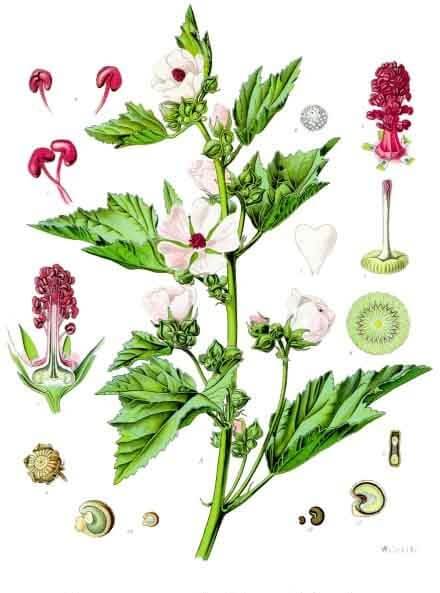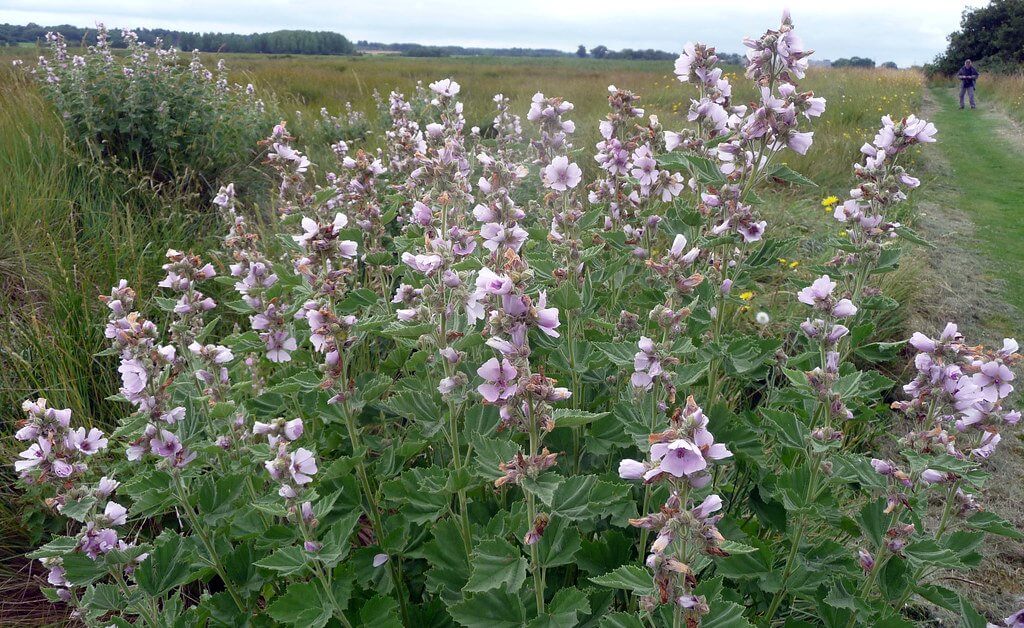
(Photo by: Franz Eugen Köhler/Wikimedia Commons)
When you hear the word “marshmallow”, you will definitely think of a puffy, white candy. And while you wouldn’t be wrong, did you know that there’s a marsh-mallow plant (Althea officinalis)? This plant inspired the texture of the modern sweet treat. Ancient Egyptians used to make the dessert by mixing honey and nuts with the mallow sap. This plant is a perennial species that’s native to Europe, North Africa, and Western Asia. This plant is commonly cultivated for its culinary and medicinal benefits.
Edibility and culinary use
Marsh-mallow is a wonderful food source. The entire plant is edible and each part offers tremendous health benefits. Aside from being an ancient marshmallow ingredient, mallow roots are often boiled to make tea. Due to being mucilaginous, this tea has a gummy texture that can help soothe your throat. Mallow tea has an earthy flavor which can taste somewhat bland to some people. That’s why they’re usually served with honey. The roots can also be eaten raw after being washed.
Much like the roots, young mallow leaves and tender flowers are also mucilaginous. For this reason, they’re usually added as thickening agents to soups, sauces, and stews. You can also slice and serve them in salads or desserts to add a touch of sweetness. And surprisingly, they taste amazing deep-fried. Lastly, the seeds can be roasted and ground to make some delicious, non-caffeine “coffee”.
Health benefits
As an ancient medicinal herb, marsh-mallow has been used as a herbal remedy for thousands of years. Marsh-mallow owes its healing powers to its high mucilaginous content. It’s useful for treating cough, colds, and irritated throats. It’s also great for treating digestive conditions such as stomach ulcers, constipations, heartburns, and intestinal colic. Moreover, the mucilage can help repair the stomach lining and respiratory tract mucus lining.
You can also use marsh-mallow topically. It has an anti-inflammatory effect that’s effective for treating eczema and dermatitis as well as relieving arthritis and joint pain. Additionally, it has antibacterial properties that can help fight skin infections, reduce skin inflammations, and promote wound healing.
Cultivation

(Photo by: gailhampshire/Flickr)
If you wish to grow marsh-mallow in your own garden, you’re in luck. Cultivating marsh-mallow isn’t hard. Placing it in the right spot is your key for a healthy marsh-mallow plant. The most important thing you need to keep in mind is that this plant needs moist, rich soil to thrive. It also needs full sunlight exposure, but it can tolerate partial sunlight as well. In the wild, marsh-mallow plants usually grow in the marshes. So, be sure to give them lots of water regularly and don’t let it dry out. This plant doesn’t need to be fertilized often, just once every two years or so will do.
Begin with stratifying your seeds to make sure they will germinate properly. Do this by mixing the seeds with sand and placing them in a plastic bag. Let them sit out for a full day, then refrigerate for 4 to 6 weeks, shaking them once in a while. After they’ve germinated, transplant them indoors. Transfer them to your garden in mid to late spring and give about 2’ space in between each plant to avoid overcrowding.
You may start harvesting the leaves in the late summer of the first year. But its white and pink flowers will not start blooming until the next summer. You can harvest the flowers immediately once they appear. As for the roots, the plant may take a few more years to produce roots that are large and good enough for herbal medicine. These large roots are best harvested in the fall or early spring.
Cautions

(Photo by: Alberto Salguero/Wikimedia Commons)
Marsh-mallow is generally safe to consume, but there have been reports that it may interfere with the absorption of medications, consult with a doctor before consuming. It can also increase the risk of bleeding, so avoid it at least 2 weeks before a scheduled surgery. Marsh-mallow might induce hypoglycemia. People with diabetes shouldn’t consume this herb.
Conclusion
Marsh-mallow is definitely a great plant to have around. With its lovely light pink and white flowers, it’s a great ornamental plant. At the same time, it also serves as a useful herbal medicine and as a nutritious food source. Besides, having marsh-mallow growing in your backyard can be a great conversation starter, don’t you think?
---------------
Writen by Cornelia Tjandra
Cornelia is a freelance writer with a passion for bringing words to life and sharing useful information with the world. Her educational background in natural science and social issues has given her a broad base to approach various topics with ease. Learn more about her writing services on Upwork.com or contact her directly by email at cornelia.tjandra@gmail.com
Many of our readers find that subscribing to Eat The Planet is the best way to make sure they don't miss any of our valuable information about wild edibles.
See our privacy policy for more information about ads on this site






